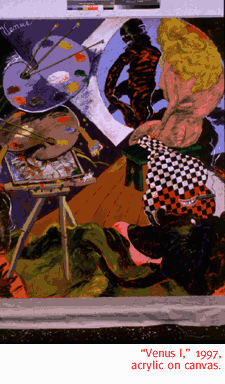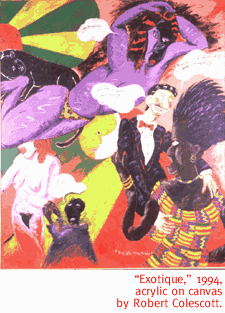

|

'Robert Colescott: Recent Paintings' Is A Sumptuous Display Of Politically Charged Narrative.
By Margaret Regan
OUT OF AFRICA metaphorically, and out of Italy literally,
Robert Colescott's paintings are come home at last to Tucson.
Now mounted in a sumptuous exhibition at the University of Arizona
Museum of Art, Robert Colescott: Recent Paintings first
went up at the Venice Biennale a year and a half ago. The work
of UA professor emeritus Colescott, these extravagantly colored,
politically charged narrative paintings were the U.S. entry in
the 1997 international art fair. Colescott was the first American
painter since Jasper Johns in 1988 to be thus honored, and the
first ever African-American artist to represent the U.S. with
a solo show.
 Since then the paintings have stopped in Minneapolis and in Queens,
dropping down to 17 large acrylics on canvas from the 20 in the
Venice exhibition. For its first showing in Tucson--and Colescott's
first-ever large scale show in his adopted hometown--the UAMA
added one painting, "Beauty Is Only Skin Deep," from
its own collection.
Since then the paintings have stopped in Minneapolis and in Queens,
dropping down to 17 large acrylics on canvas from the 20 in the
Venice exhibition. For its first showing in Tucson--and Colescott's
first-ever large scale show in his adopted hometown--the UAMA
added one painting, "Beauty Is Only Skin Deep," from
its own collection.
A note at the entrance to the UAMA galleries incongruously states:
"This exhibition is an official presentation of the U.S.
government." If so, this is a government representing a culture
attractively amenable to self-examination. While Colescott's work
on a visceral level is a joyful, jazzy explosion of color, a delirious
amalgam of thick paint and edgy lines, on the cerebral level it's
an attack on racism and all its works by an artist provocateur.
Traveling easily across cultures and centuries, Colescott's paintings
don't stop at the American experience of slavery and segregation.
He paints about colonialism in Africa, about miscegenation in
Martinique, about Caucasian usurpation of African cultural forms
in music and dance and cuisine. He's confrontational in his re-use
of stereotypes, forcing uneasy viewers to ponder their own biases.
A black man with a gun aims right at us in "School Days,"
and black hookers show off their wares. A scary black Quasimodo
carries off a white Esmeralda in "The Hunchback of Notre
Dame: Homage to Victor Hugo." An urban drunk sprawls collapsed
against a trash can in "Bilingual Cop."
But always he pays attention to beauty. "White Boy"
is an inventively composed work that shatters all conventions
of perspective and proportion to make an unreal space: Here, in
a place we can't quite conceive, a black woman and a white man
lie together in erotic bliss.
 "El Tango," 1995, is divided into shapely fields of
flat hues--green, yellow, blue, black--whose dancing shapes are
summoned up by the tango's own rhythms. Cascading across this
abstracted space are an assortment of human figures. A suave Argentine
in mustache looks on a woman in a dance dress, and finds that
she has two faces, one unmistakably African. A couple of cartoon
figures argue: "Your Tango??" demands a black man. "Yes,
from Spain," retorts a white woman. It's a work of cultural
salvage, retracing the tango to its African roots.
"El Tango," 1995, is divided into shapely fields of
flat hues--green, yellow, blue, black--whose dancing shapes are
summoned up by the tango's own rhythms. Cascading across this
abstracted space are an assortment of human figures. A suave Argentine
in mustache looks on a woman in a dance dress, and finds that
she has two faces, one unmistakably African. A couple of cartoon
figures argue: "Your Tango??" demands a black man. "Yes,
from Spain," retorts a white woman. It's a work of cultural
salvage, retracing the tango to its African roots.
Similarly, "A Taste of Gumbo," 1990, decorated by a
circle of cheerful orange crabs against blue, follows the quintessential
N'Orleans dish back to Africa, via the chain of slaves who cooked
their traditional foods for their masters. A cameo of a black
violinist in this Louisiana smorgasbord likely is a reference
to Colescott's father, a classically trained musician who worked
all his life as a train porter. A fiddler in early jazz bands
with the likes of Louis Armstrong, he fled the segregation of
New Orleans and the Deep South for a freer life in Oakland, where
his son was born.
Colescott, now age 72, has also roamed widely, and his work is
drenched in the art historical tradition. He studied at Berkeley
during the heyday of the abstract expressionists; a catalog essay
by independent curator Miriam Roberts makes the point that their
serious intentions and big canvases are reflected in his own,
narrative though they be. He studied under Léger in Paris,
and an homage to Léger's cubist takes on the machine age
shows up in "Hard Hats."
He soaked up Egyptian and African art during a period of teaching
in Cairo, incorporating non-western art that is both linear and
figurative.
The painter deliberately mixes up all these styles to underline
his points. "The Blues for the Muse" counterpoises dark
linear drawings of black blues musicians below an arc of lavishly
painted icons of Western art: the lyre, the palette, the Greek
temple. In between these polarities is a portrait of Alexandre
Dumas, author of French adventure tales, who turns out to have
been the son of a woman of Martinique and man of France. Colescott
also co-opts cartoon figures, particularly the exaggerated Zip
Coons and Jim Crows of 19th- and early 20th-century popular culture.
Some years ago, he made his reputation for his reworking of famous
paintings of Western art, a Washington Crossing the Delaware
aided by blacks drawn in stereotypically racist forms.
 In more recent years, Colescott has gone on to even bigger themes.
"Triumph of Christianity," 1993, is a sweeping condemnation
of religion put to the uses of greed. Organized into a classical
composition, it puts at center an uninspiring Jesus holding his
arms wide over the colonial world. At left is a map of Africa,
and a black slave in chains among piles of bananas; at right are
the Americas, and a Native American in chains among corn. In between,
an exalted hamburger, icon of American capitalism, glows in a
halo. All this for that, the painting says: cynical religiosity,
aided and abetted by racism, helped make the world safe for profit.
In more recent years, Colescott has gone on to even bigger themes.
"Triumph of Christianity," 1993, is a sweeping condemnation
of religion put to the uses of greed. Organized into a classical
composition, it puts at center an uninspiring Jesus holding his
arms wide over the colonial world. At left is a map of Africa,
and a black slave in chains among piles of bananas; at right are
the Americas, and a Native American in chains among corn. In between,
an exalted hamburger, icon of American capitalism, glows in a
halo. All this for that, the painting says: cynical religiosity,
aided and abetted by racism, helped make the world safe for profit.
"Venus I," 1996, tackles the conventions of art and
beauty, and America's reluctance to acknowledge its mixed racial
heritage. An artist's easel and palettes are set against a space
forever shattered by modernism. A downtrodden black woman lies
at bottom, a slave, perhaps, whose big cartoon lips did not deter
the white men whose lust helped make her a mother-of-us-all. She's
never enjoyed the admiration of artists, however. Above her a
conventional artist's model, a nude blonde, gazes into the conventional
mirror, but she's been transformed in the looking glass. Looking
back at her, proudly displaying her body, is a woman black as
night.
Robert Colescott: Recent Paintings continues through
Sunday, January 3, at the University of Arizona Museum of Art.
Free talks on the show are scheduled for 12:15 p.m. on Wednesdays,
December 2 and 9. Regular gallery hours are 9 a.m. to 5 p.m. Monday
through Friday, noon to 4 p.m. Sunday. Call for holiday hours.
For more information call 621-7567.

|
 |





